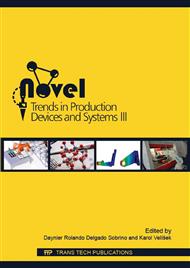[1]
S.F. Jiang, C.D. Lu, Review of Gas-Assisted Injection Molding Process, Advanced Materials Research, vol. 69-70, (2009) pp.645-648, ISSN: 1662-8985, DOI: 10. 4028/www. scientific. net/AMR. 69-70. 645.
DOI: 10.4028/www.scientific.net/amr.69-70.645
Google Scholar
[2]
Ch. Shia-Chung, K. Yuan, Yeh. Hsien-Yang, Effect of Gas Channel Design on Bending Properties of Gas-Assisted Injection Molded Polystyrene Parts, Journal of Reinforced Plastics and Composites. vol. 17, no. 13, (1998).
DOI: 10.1177/073168449801701306
Google Scholar
[3]
Ch. ReanDer, C. Shia-Chung, J. MingChang, Y. Hwei-Yen, Mechanical properties of gas- assisted injection moulded PS, PP and Nylon parts, Polymer. vol. 40, no. 11, (1999) p.2949–2959, ISSN 0032-3861, DOI: 10. 1016/S0032-3861(98)00525-4.
DOI: 10.1016/s0032-3861(98)00525-4
Google Scholar
[4]
Z. Guo-Qiang, Y. Wei, H. Li, Y. Ming-Bo, L. Wei, L. Chuan-Tai, Flow-induced Fiber Orientation in Gas-assisted Injection Molded Part, Materials Letters. vol. 61, no. 16, (2007) p.3436–3439, ISSN 3436-3439, DOI: 10. 1016/j. matlet. 2006. 11. 085.
DOI: 10.1016/j.matlet.2006.11.085
Google Scholar
[5]
Z. Guo-Qiang, H. Li, Y. Wei., Y. Bin, Y. Ming-Bo, L. Qian, Hierarchical Crystalline Structure of HDPE Molded by Gas-assisted Injection Molding, Polymer. vol. 48, no. 19, (2007).
DOI: 10.1016/j.polymer.2007.05.047
Google Scholar
[6]
H. Li, Y. Wei, Y. Bin, Y. Mingbo, Z. Guoqiang, A. Haining, Banded Spherulites of HDPE Molded by Gas-assisted and Conventional Injection Molding, Polymer. vol. 49, no. 19, (2008).
DOI: 10.1016/j.polymer.2008.07.005
Google Scholar
[7]
T. Stachowiak, T. Jaruga, Structure of gas-assisted injection moulded parts, Journal of Achievements in Materials and Manufacturing Engineering. vol. 38, no. 2, (2010) pp.139-145, ISSN 1734-8412.
Google Scholar
[8]
L. Ying, Y. Wei, Z. Kai, Y. Ming-bo, Stress relaxation behavior of high density polyethylene (HDPE) articles molded by gas-assisted injection molding, Polymer Testing. vol. 29, no. 7, (2010).
DOI: 10.1016/j.polymertesting.2010.03.005
Google Scholar
[9]
F. Randy, Water-Assist Injection Molding (WAIM). UL Prospector - Knowledge Center, BASF - The Chemical Company, Ltd., (2007) Information on: www. knowledge. ulprospector. com/1517/water-assist-injection-molding.
Google Scholar
[10]
J. Avery, Gas-Assist Injection Molding: Principles and Applications, Hanser Gardner Publications, Inc., Ohio, 203 pages, 2001. ISBN 9781569902981.
Google Scholar
[11]
P. Dier, R. Goralski, Gas Assist Injection Molding, Bauer Compressors. Inc., (2000).
Google Scholar
[12]
L. Yu-Chih, H. Chao-Tsai, Ch. Tzu-Chau, S. Tsung-Min, Integration of Injection Molding and Structure Simulation for Part Lifecycle and Mold Deformation Analyses, CoreTech System (Moldex3D) Co. Ltd., ChuPei City, HsinChu, Taiwan. (2012).
Google Scholar
[13]
Ch. Rong-Yeu, Y.P. Allen, Y. Wen-Hsien, C.H. David, Seamless integration of injection molding and structure analysis tools, CoreTech System (Moldex3D) Co. Ltd. / National Tsing-Hua University, HsinChu, Taiwan, ROC. (2005).
Google Scholar
[14]
CoreTech System Co., Ltd., Moldex3D - Solution Add-on (User Manual - ver. R13), Gas- Assisted Injection Molding (GAIM), Mathematical Models and Assumptions.
Google Scholar
[15]
CoreTech System Co., Ltd., Moldex3D Gas-Assisted Injection Molding (GAIM) Functionalities and Features. Moldex3D R11 European Webinar Series (2011).
Google Scholar
[16]
S. Loyd, CoreTech System Co., Ltd., Industrial Application and Advanced Technology of Fluid-Assisted Injection Molding (FAIM). Moldex3D R11 European Webinar Series. (2012).
Google Scholar


